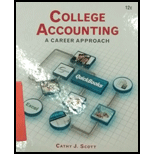
Concept explainers
The __________ represents the sequence of steps in the accounting process.
- a. fiscal year
- b. fiscal period
- c. accounting cycle
- d. work sheet
Find the correct option that indicates the correct term for the given explanation.
Answer to Problem 1QY
The correct answer is option (c).
Explanation of Solution
Accounting cycle: The whole process of identifying, sorting, analyzing, and recording the transactions, journalizing the transactions, posting the entries, preparation of trial balance, updating the adjustments in worksheet, preparing financial statements, and closing the books, is referred to as accounting cycle.
Justification for correct answer: Accounting cycle is the complete process of recording transaction, journalizing, posting, preparation of financial statements. Hence, option (c) is correct.
Justification for incorrect answers:
- Option (a) is incorrect because fiscal year is the accounting period of a company in which a public company reports or covers its financial statements in the 12 consecutive months.
- Option (b) is incorrect because fiscal period is the period in which a company completes its accounting cycle in the 12 consecutive months.
- Option (d) is incorrect because worksheet is an accounting tool that help accountants to record adjustments and up-date balances required to prepare financial statements.
Therefore, option (c) is correct answer.
Want to see more full solutions like this?
Chapter 4 Solutions
College Accounting (Book Only): A Career Approach
Additional Business Textbook Solutions
Operations Management: Processes and Supply Chains (12th Edition) (What's New in Operations Management)
Horngren's Cost Accounting: A Managerial Emphasis (16th Edition)
Horngren's Accounting (12th Edition)
Intermediate Accounting (2nd Edition)
Financial Accounting, Student Value Edition (5th Edition)
Essentials of MIS (13th Edition)
- Green, an individual taxpayer who is not a day trader, has requested assistance from a CPA to calculate Year 2 gains and/or losses on the sale of various shares of stock. For each of the following transactions, calculate the correct gain or loss and enter the amount in the associated box in the Gain or Loss column. 4. Sold 1,225 shares of ABC Corp. stock at $9 per share. Green purchased 600 shares several years ago at $30 per share. Three years ago, when the stock price was $21, there was a 2-for-1 stock split, and two years ago, when the stock price was $25, there was a 3-for-2 stock split. No other shares were sold by Green before Year 2. 5. Sold 500 shares of XYZ Corp. stock at $20 per share. Green purchased these shares two years prior at $22 per share. Three weeks prior to the sale, Green purchased 100 shares of XYZ stock at $18 per share. 6. Sold 1,600 shares of BX Corp. stock at $4 per share. Green received these shares as a gift from his sister four years ago. The fair market…arrow_forwardAlessandra Manufacturing produces various electronic components. Last year, the company's variable costing net operating income was $92,400, and ending inventory increased by 1,800 units. Fixed manufacturing overhead cost per unit was $5. Determine the absorption costing net operating income for last year.arrow_forwardGreen, an individual taxpayer, who is not a day trader, has requested assistance from a CPA to calculate Year 2 gains and/or losses on the sale of various shares of stock. For each of the following transactions, calculate the correct gain or loss and enter the amount in the associated box in the Gain or Loss column. 1. Sold 200 shares of Y Corp. stock at $14 per share. Green received the 200 shares as a gift from his brother three years ago, when the shares had a fair market value of $10 per share. Green's brother purchased the stock for $16 per share. 2. Sold 200 shares of Y Corp. stock at $22 per share. Green received the 200 shares as a gift from his brother three years ago, when the shares had a fair market value of $26 per share. Green's brother purchased the stock for $16 per share. 3. Sold 450 shares of Z Corp. stock at $40 per share. Green received the 450 shares from his aunt's estate as a bequest. The fair market value of the stock at the date of his aunt's death was $32 per…arrow_forward
- Gross profit would be_.arrow_forwardWhat is Bobby's 2019 net income using accrual accounting?arrow_forwardJob 786 was one of the many jobs started and completed during the year. The job required $8,400 in direct materials and 35 hours of direct labor time at a total direct labor cost of $9,300. If the job contained five units and the company billed at 70% above the unit product cost on the job cost sheet, what price per unit would have been charged to the customer?arrow_forward
- What is the company's gross profit?arrow_forwardMOH Cost: Top Dog Company has a budget with sales of 7,500 units and $3,400,000. Variable costs are budgeted at $1,850,000, and fixed overhead is budgeted at $970,000. What is the budgeted manufacturing cost per unit?arrow_forwardWhat was Ghana's cost of goods sold for 2023?arrow_forward
 College Accounting (Book Only): A Career ApproachAccountingISBN:9781337280570Author:Scott, Cathy J.Publisher:South-Western College PubPrinciples of Accounting Volume 1AccountingISBN:9781947172685Author:OpenStaxPublisher:OpenStax College
College Accounting (Book Only): A Career ApproachAccountingISBN:9781337280570Author:Scott, Cathy J.Publisher:South-Western College PubPrinciples of Accounting Volume 1AccountingISBN:9781947172685Author:OpenStaxPublisher:OpenStax College


